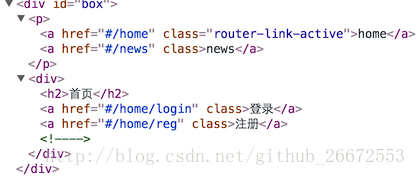模板抽离
我们已经学习过了Vue模板的另外定义形式,使用<template></template>。
<!-- 模板抽离出来 -->
<template id="home">
<div>首页</div>
</template>
<template id="news">
<div>新闻</div>
</template>然后js里定义路由组件的时候:
// 1. 定义(路由)组件。
const Home = { template: '#home' };
const News = { template: '#news' };路由嵌套
实际应用界面,通常由多层嵌套的组件组合而成。比如,我们 “首页”组件中,还嵌套着 “登录”和 “注册”组件,那么URL对应就是/home/login和/home/reg。
<template id="home">
<!-- 注意:组件只能有一个根元素,所以我们包装到这个div中 -->
<div>
<h2>首页</h2>
<router-link to="/home/login">登录</router-link>
<router-link to="/home/reg">注册</router-link>
<!-- 路由匹配到的组件将渲染在这里 -->
<router-view></router-view>
</div>
</template>/home
后的模板,其中我们需要把
/home/login
和
/home/reg
渲染进来。
完成上面代码后,HTML结构如下图:
- 登录和注册2个组件
<template id="login">
<div>登录界面</div>
</template>
<template id="reg">
<div>注册界面</div>
</template> <template id="login">
<div>登录界面</div>
</template>
<template id="reg">
<div>注册界面</div>
</template> // 2. 定义路由
const routes = [
{ path: '/', redirect: '/home' },
{
path: '/home',
component: Home,
children:[
{ path: '/home/login', component: Login},
{ path: '/home/reg', component: Reg}
]
},
{ path: '/news', component: News}
]注意我们在home路由配置了它的children。这就是嵌套路由。
3. 案例全部代码如下:
<!DOCTYPE html>
<html>
<head>
<title></title>
<meta charset="utf-8">
<script src="http://unpkg.com/vue/dist/vue.js"></script>
<script src="https://unpkg.com/vue-router/dist/vue-router.js"></script>
</head>
<body>
<div id="box">
<p>
<router-link to="/home">home</router-link>
<router-link to="/news">news</router-link>
</p>
<router-view></router-view>
</div>
<!-- 模板抽离出来 -->
<template id="home">
<!-- 注意:组件只能有一个根元素,所以我们包装到这个div中 -->
<div>
<h2>首页</h2>
<router-link to="/home/login">登录</router-link>
<router-link to="/home/reg">注册</router-link>
<!-- 路由匹配到的组件将渲染在这里 -->
<router-view></router-view>
</div>
</template>
<template id="news">
<div>新闻</div>
</template>
<template id="login">
<div>登录界面</div>
</template>
<template id="reg">
<div>注册界面</div>
</template>
<script type="text/javascript">
// 1. 定义(路由)组件。
const Home = { template: '#home' };
const News = { template: '#news' };
const Login = { template: '#login' };
const Reg = { template: '#reg' };
// 2. 定义路由
const routes = [
{ path: '/', redirect: '/home' },
{
path: '/home',
component: Home,
children:[
{ path: '/home/login', component: Login},
{ path: '/home/reg', component: Reg}
]
},
{ path: '/news', component: News}
]
// 3. 创建 router 实例,然后传 `routes` 配置
const router = new VueRouter({
routes // (缩写)相当于 routes: routes
})
// 4. 创建和挂载根实例。
// 记得要通过 router 配置参数注入路由,
// 从而让整个应用都有路由功能
const app = new Vue({
router
}).$mount('#box')
// 现在,应用已经启动了!
</script>
</body>
</html>转载出自: http://blog.csdn.net/github_26672553/article/details/54861174























 105
105

 被折叠的 条评论
为什么被折叠?
被折叠的 条评论
为什么被折叠?








